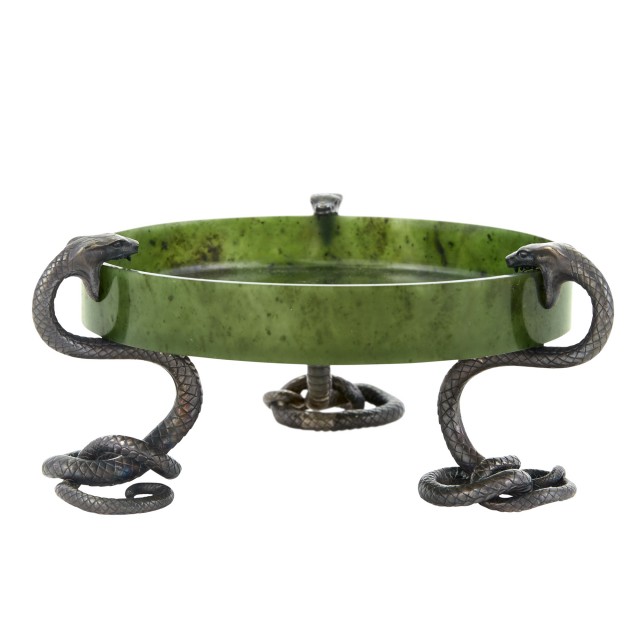The Sinuous Snakes of Fabergé
10/24/2018 General

NEW YORK, NY -- Doyle’s upcoming Russian Works of Art auction offers the opportunity to own a piece of history that shares the same early visual vocabulary as Imperial Easter Eggs and objets de vertu. The snake motif of Fabergé graces some of the most important art collections in the world, including The Royal Collection Trust, The Metropolitan Museum of Art, The Fabergé Museum, and esteemed private collections. A Fabergé silver-mounted nephrite dish in the upcoming sale is part of the rich history of Fabergé’s snake motif and the evolution from classicism to Art Nouveau.
When one hears the name Fabergé, one is instantly transported to Russia in 1900 at the height of the Empire, with a fate that delicately teeters in the balance but is soon to fall. Peter Carl Fabergé was able to turn his father’s humble jewelry shop into one of the world’s leading jewelry houses, not relying on the material’s intrinsic value, but rather elevating those materials with expert craftsmanship. Fabergé followed the taste of the Imperial family, which was French Neoclassical, having been popularized by Catherine the Great in the late 18th century. While Art Nouveau and the Russian Avant-garde were en vogue, Fabergé catered to the classical taste of court. Fabergé would have been well versed in Japonisme, and it would become part of his artistic repertoire that included the Rococo styles and many others.
The early beginnings of Art Nouveau can be seen in the 1895 Blue Serpent Clock Egg given to Empress Maria Feodorovna by her husband Emperor Alexander III. The serpent coils and climbs the classical styled egg. Like so many treasures the Blue Serpent Clock Egg was confiscated in the aftermath of the Russian Revolution.
In 1902 the Duchess of Marlborough, the former Consuelo Vanderbilt, had a pink version of the Blue Serpent Clock Egg commissioned. The egg itself is very similar, only varying in color and other small details. The biggest change is the snake. It is depicted with more grace and movement. The body of the snake lifts from the egg, while the Blue Serpent Clock Egg’s snake makes constant contact with the egg and does not lift from it. In the span of seven years, the snake became more curvilinear and naturalistic, which were major influences from the Art Nouveau movement.
The 1907 Yusupov Egg is similar to both the 1895 Blue Serpent Clock Egg and the 1902 Duchess of Marlborough Egg with the classical design being the setting for the diamond set snake. As Art Nouveau gained popularity, its influences can be seen in the progression of the snake. The 1907 Yusupov Egg snake is more stylized but more curvilinear than the two previous.
The snake motif fits perfectly into the vocabulary of Art Nouveau, and it already had a strong history in Victorian motifs as a symbol of eternal love when it was biting its own tail. In 1908 Mrs. George Keppel gave King Edward VII a blue enamel cigarette case with a supplely applied curvilinear diamond snake biting its own tail wrapping around the entire case. A familiar motif that Edward would have known from his mother Queen Victoria’s wedding ring. The ring was this exact symbol, a snake biting its own tail. This poignant symbolism shows the affection between King Edward and his mistress and is one of the true examples of pure Art Nouveau design from Fabergé.
The Metropolitan Museum of Art has a superb example of the Fabergé snake motif (accession number: 2014.698.2) that is currently on view in the American Wing’s Visible Storage. The piece is a collaboration between two of the largest design houses in the world Fabergé and Tiffany Studios. Fabergé’s workmaster, Viktor Aarne, created the silver gilt snake mounts that wrap around the Tiffany Studios Favrile glass vase and is quintessentially Art Nouveau.
Both Doyle’s Fabergé silver-mounted nephrite dish and the Met’s example look like they are weightlessly suspending their vessels. This is due to the same craftsman who worked on each piece. Fabergé allowed their workmasters to maintain their own workshops under the Fabergé name, and therefore they were able to hallmark the pieces they produced. Both Doyle’s dish and the Met’s pieces are hallmarked by Viktor Aarne. They share the same visual history as the above-mentioned pieces and the same maker as the collaborative vase in the collection of The Metropolitan Museum of Art.
While enjoying the crisp fall weather this weekend, drop by Doyle to view the marvelous example of Art Nouveau Fabergé. Then, make the short jaunt over to The Metropolitan Museum of Art’s collection to see the similarities between the two pieces and the craftsmanship of Viktor Aarne and Fabergé.
Russian Works of Art
Auction October 31, 2018 at 10am
Exhibition October 27 - 29
Lot 203
Fabergé Silver-Mounted Nephrite Dish
Workmaster Victor Aarne, St. Petersburg, 1899-1904
The shallow circular carved nephrite dish with coiled snake-form supports.
Height 2 1/2 inches (6.4 cm), diameter of dish 4 1/2 inches (11.4 cm).
Est. $8,000-12,000